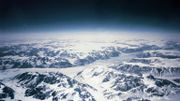
Southeast coast of Greenland
It is hard to shock journalists and at the same time leave them in awe of the power of nature. A group returning from a helicopter trip flying over, then landing on, the Greenland ice cap at the time of maximum ice melt last month were shaken.
One shrugged and said: “It is too late already.”
What they were all talking about was the moulins, not one moulin but hundreds, possibly thousands. “Moulin” is a word I had only just become familiar with. It is the name for a giant hole in a glacier through which millions of gallons of melt water cascade through to the rock below. The water has the effect of lubricating the glaciers so they move at three times the rate that they did previously.
Some of these moulins in Greenland are so big that they run on the scale of Niagra Falls. The scientists who accompanied these journalists on the trip were almost as alarmed. That is pretty significant because they are world experts on ice and Greenland in particular. We were visiting Ilulissat, Greenland, once a stronghold of Innuit hunters but now with so little ice that the dog sleds are in danger of falling through even in the depth of winter. But it is not the lack of sea ice that worries scientists and should be of serious concern to the inhabitants of coastal zones across the world. Cities like New York and states like Florida are in the front line.
Scientists know this already, but just to give you some idea of the problem, the Greenland ice cap is melting at such a fast rate it is triggering earthquakes as pieces of ice several cubic kilometres in size break up.
Read moreIce Caps Melting Fast: Say Goodbye to the Big Apple?

